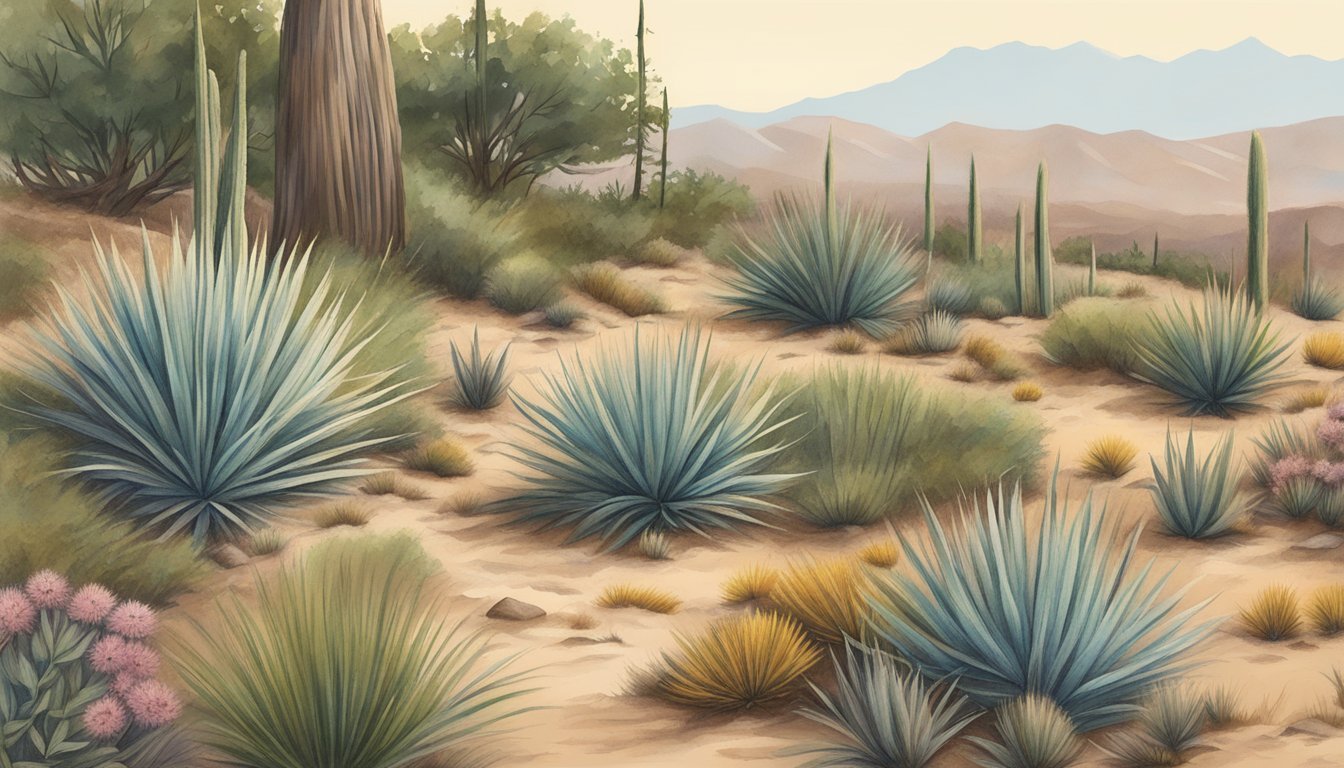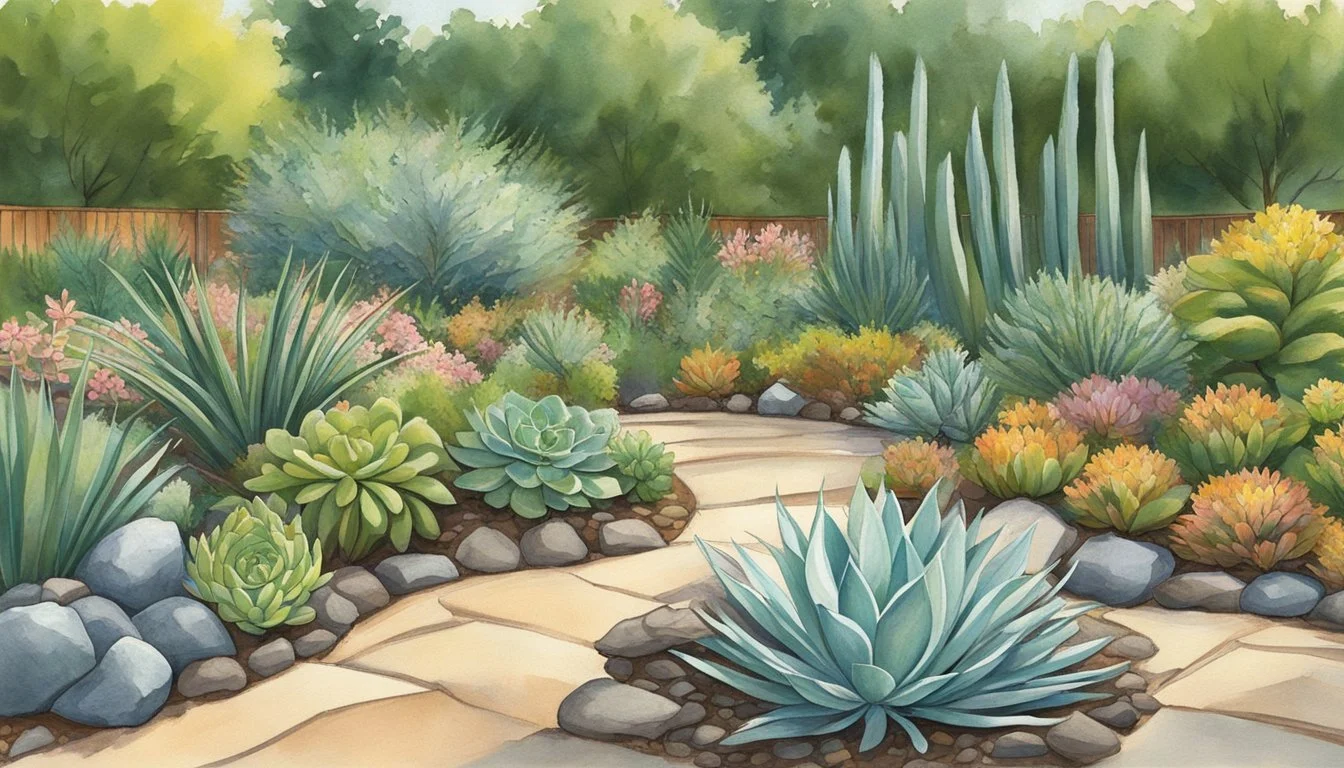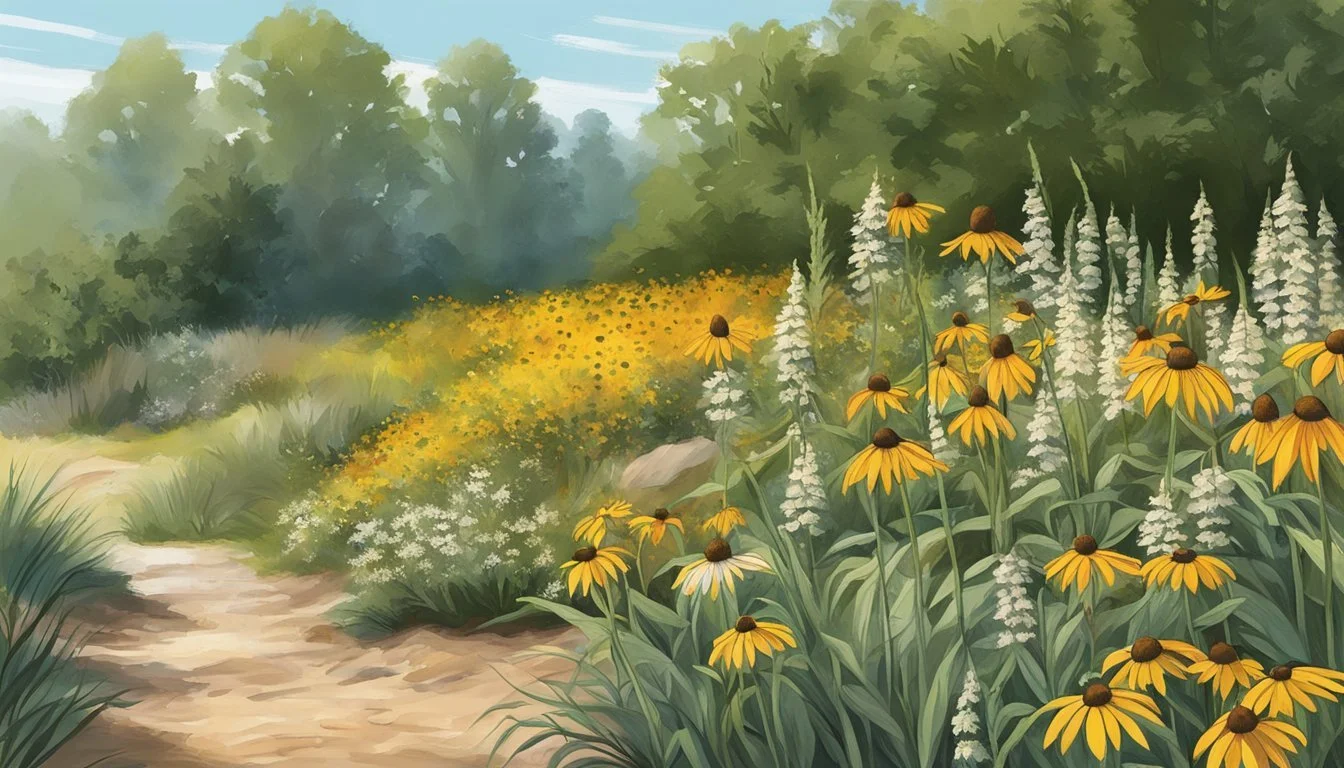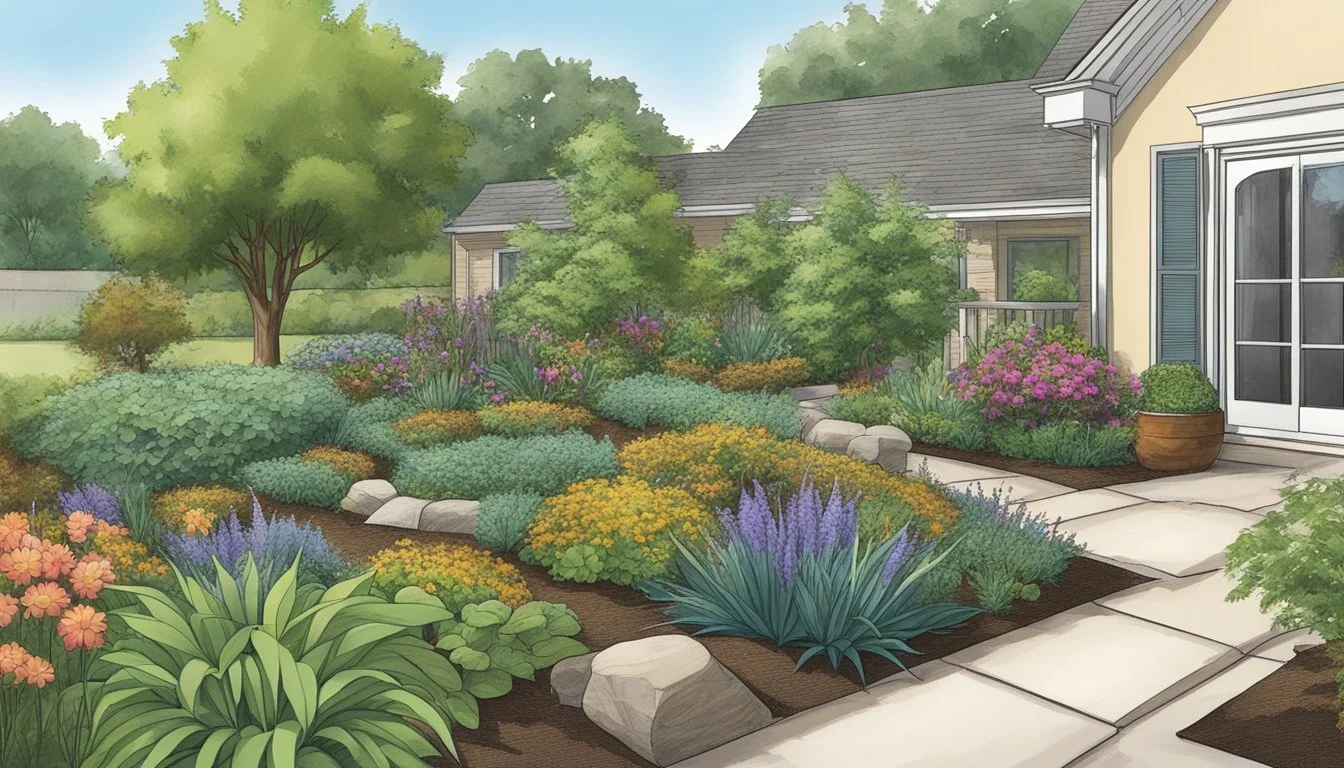Drought-Tolerant Plants in Kentucky
A Guide to Resilient Gardening
In Kentucky, where the climate can present challenges with periodic droughts, selecting the right plants for the landscape is crucial. Drought-tolerant plants are a valuable addition to any garden or landscape in the region, as they are adapted to survive with minimal rainfall. These resilient plants not only conserve water but also reduce maintenance needs and uphold their aesthetic appeal even under stress from limited water resources.
The selection of drought-tolerant plants for Kentucky gardens can range from native species to well-adapted non-native plants. Native species, such as the vibrant Butterfly Milkweed, offer the dual advantages of drought tolerance and ecological benefits, supporting local pollinators like monarch butterflies. Non-native species can also be appropriate choices, provided they are non-invasive and suited to Kentucky's USDA hardiness zones.
Enthusiasts looking to cultivate a low-maintenance and environmentally sustainable landscape will find that integrating plants like the stately Purple Coneflower and the hardy Crossvine cultivar 'Jekyll' can lead to a thriving garden. Thoughtful selection of such plants ensures gardens are not only resilient to the dry spells but also contribute positively to the local biodiversity.
Understanding Drought Tolerance
Drought tolerance refers to the ability of plants to withstand periods without water, a trait increasingly critical as climate change impacts weather patterns. This section explores the specific characteristics and advantages of drought-tolerant plants.
Adaptations in Drought-Tolerant Plants
Drought-tolerant plants, such as those found in Kentucky, have evolved various adaptations to survive in water-limited environments. Physiological and biochemical strategies enable these species to maintain function and structure under water-stressed conditions. Examples include the development of deep root systems for water acquisition and the production of drought responsive proteins that protect cellular integrity. Additionally, certain plant hormones facilitate essential survival processes, and metabolic alterations, such as the accumulation of osmoprotectants, help to stabilize cells during water deficit.
Deep root systems
Production of protective proteins
Hormonal regulation
Metabolic alterations like osmolyte accumulation
Benefits of Planting Drought-Tolerant Species
Incorporating drought-tolerant plants into landscapes is beneficial, especially in regions facing water restrictions and the uncertain effects of climate change. These species require less water, reducing dependence on irrigation and conserving precious water resources. They also contribute to biodiversity and ecosystem stability, offering habitat and sustenance to various wildlife species. By planting drought-tolerant cultivars, gardeners and farmers can create resilient green spaces that are better equipped to endure environmental stressors.
Reduced water dependency
Conservation of water resources
Support for biodiversity and ecosystem services
Creation of resilient landscapes
Selecting the Right Plants for Kentucky
When choosing plants for Kentucky gardens, selecting species that thrive in the state's varied hardiness zones and can withstand drought conditions is crucial. Here is a guide to drought-tolerant trees, shrubs, perennials, and annuals ideal for Kentucky landscapes.
Drought-Tolerant Trees and Shrubs
Trees suitable for the drier climates of Kentucky include the resilient Kentucky Coffee Tree, offering a grand canopy and fall interest. Shrubs such as the native Butterfly Bush and drought-tolerant Boxwood varieties serve as excellent choices for water-conserving landscapes. For detailed guidance on hardiness zones specific to Kentucky regions, consider consulting the Kentucky Hardiness Zone.
Perennial Choices for Resilience
The Coneflower and Black-eyed Susan stand out as perennials with high drought tolerance, requiring minimal watering while providing vibrant color. Incorporating native Ornamental Grasses like Blue Fescue can enhance texture with the added benefit of water-wise gardening.
Annuals and Their Role
Annuals like Zinnias and Marigolds not only add a burst of color but can also manage well in drier conditions when established. Integrating these annuals in areas with other drought-resistant plants can lead to a cohesive and sustainable garden design. For a hardy climbing vine that's an annual in colder climates but perennial in milder ones, the vigorous and adaptable Crossvine is a standout.
Designing Your Drought-Resistant Landscape
Designing a drought-resistant landscape in Kentucky involves thoughtful selection of plants that thrive in dry conditions without sacrificing visual interest. The incorporation of various colors, textures, as well as the strategic use of ornamental grasses and succulents all play a pivotal role.
Incorporating Color and Texture
One can achieve a vibrant drought-resistant garden through careful selection of plants that offer a variety of colors and textures. Sedum, for instance, brings bright bursts of color with its star-shaped flowers, while yucca provides striking sword-shaped leaves for textural contrast. When choosing plants, consider those with silver or gray foliage such as lavender and Russian sage, which are not only visually appealing but also excellent in drought tolerance.
Utilizing Ornamental Grasses
Ornamental grasses add movement and grace to the landscape. Kentucky is home to native grasses like little bluestem and switchgrass, which are resilient to drought conditions. These grasses require minimal watering once established, create an airy backdrop for other plants, and also serve to provide texture with their leaves and plumes.
Maximizing Aesthetics with Succulents and Cacti
Succulents and cacti are quintessential elements for low-water landscaping. They can be strategically placed to create focal points or to supplement areas where other plants might struggle. In Kentucky, hardy variants like hen and chicks and stonecrop can be considered, each offering unique shapes and resilience to drought. These plants are not only practical for conserving water but also injects diversity in form, contributing to the yard's overall aesthetics.
Caring for Your Drought-Tolerant Garden
Creating a garden resilient to dry conditions involves more than choosing the right plants; it requires specific strategies in water management, soil composition, and routine care to ensure plant vitality and garden beauty.
Water Conservation Techniques
Timing and Quantity: It's crucial to water plants during the cooler parts of the day, typically early morning or late evening, to reduce evaporation. Drought-tolerant plants often thrive with less frequent but deeper watering, which encourages a stronger root system.
Drip Irrigation: Consider installing a drip irrigation system to deliver water directly to the base of each plant. This minimizes waste and ensures that water reaches the root zone where it's most needed.
Soil and Mulch Considerations
Soil Preparation: Before planting, it's beneficial to incorporate organic matter into the soil. This helps improve water retention and soil aeration, which are essential for a healthy root system.
Mulch Application: Apply a 2-3 inch layer of organic mulch, such as bark or straw, around plants to reduce moisture loss and regulate soil temperature.
Maintenance Tips for Plant Health
Pruning and Weeding: Regularly prune dead or excessively overgrown branches to promote air circulation and plant health. Keeping the area weed-free ensures that drought-tolerant plants don't compete for limited water resources.
Observation: Routinely check plants for signs of stress or damage. A confident gardener recognizes issues early and takes appropriate action to maintain plant health.
Using these targeted strategies, a gardener can confidently establish a vibrant, drought-tolerant garden that conserves water and thrives in Kentucky's varying climate.
Popular Drought-Tolerant Plants in Kentucky
In Kentucky, gardeners often look for resilient plants that can thrive with minimal watering. This section highlights popular drought-tolerant plants that are well-suited to Kentucky's climate and soil conditions.
Native Flowers and Blooms
Kentucky's landscape can be beautifully enhanced with native flowers that are both drought-resistant and vibrant. The Purple Coneflower is a standout with its striking purple petals and robust nature, attracting pollinators while requiring little moisture. Similarly, Black-Eyed Susans bring a splash of gold to gardens and are known for their toughness in dry spells.
Aster: A favorite for late-season blooms.
Coneflower: Especially the Echinacea species, known for medicinal properties and hardiness.
Russian Sage: Offers silvery foliage and purple spires, thriving in arid conditions.
Lavender: Not only drought-tolerant but also aromatic, adding a soothing fragrance to the landscape.
Hardy Shrubs and Groundcovers
Shrubs and groundcovers that can survive Kentucky's occasional droughts are essential for a low-maintenance landscape. Creeping Thyme is an excellent groundcover, with its ability to spread quickly and provide a lush carpet that seldom needs watering. Fothergilla major 'Mount Airy' is prized for its honey-scented blooms and stunning fall color, exemplifying the resilience of local shrubbery.
Creeping Thyme: Hardy and spreads easily, perfect for filling spaces with greenery.
Fothergilla major 'Mount Airy': Offers multi-season interest and is adaptable to various soil types.
Trees Fit for Kentucky Climates
Trees that can withstand long periods without rain are vital to Kentucky's ecosystems. The Kentucky coffee tree, known for its tolerance to dry conditions, provides ample shade and aesthetic appeal. Moreover, selections like the Black Gum and Lacebark Pine can endure drought, making them ideal choices for the region's changing weather patterns.
Japanese tree lilac
Black Gum
Lacebark Pine
American Holly
American Plum
Eastern Red Cedar
Kentucky Coffee Tree
Pawpaw
Persimmon
Pecan
Red Mulberry
River Birch
Serviceberry
Sugar Maple
Honeylocust
Focusing on these drought-tolerant plants can result in a garden that is both resilient and beautiful, despite the challenges posed by Kentucky's variable climate.
Incorporating Non-Native Drought-Resistant Varieties
In Kentucky landscapes, the integration of non-native, drought-resistant plants can offer a robust, water-wise gardening solution. These species can provide striking aesthetics and practical resilience to dry conditions.
Exotic Options for Kentucky Landscapes
For those seeking to enrich their gardens with drought-tolerant variety, Sedum presents a vast array of species known for their hardiness and succulent leaves. Often referred to as stonecrop, Sedums can thrive in tough conditions with minimal water once established. Another robust genus is Salvia, with some species like Salvia greggii providing long-lasting blooms and a notable tolerance to dry spells.
Portulaca, also known as moss rose, is prized for its vibrant, multicolored flowers and exceptional drought resistance. Gaillardia, or blanket flower, offers eye-catching patterns while being extremely water-efficient. In addition, Yucca, with its striking architectural presence, can withstand prolonged dry periods, making it a valuable addition to any Kentucky garden seeking drought tolerance and visual interest.
Managing Non-Natives Responsibly
When integrating non-native plants, it's crucial to manage them responsibly to prevent unintended impacts on local ecosystems. Plants such as Lantana can be invasive in certain areas, so it is essential to select cultivars that are less likely to spread aggressively.
Gardeners must also pay attention to underground propagation methods. Many drought-tolerant plants, such as those with rhizomes, can spread rapidly, which, while beneficial in reducing watering needs, can lead to overgrowth if not managed properly.
Planting Artemisia offers a silvery foliage that complements many garden designs and is well-suited for Kentucky's periodic droughts. Yarrow provides a similar function, with its fern-like leaves and widespread umbrella-shaped flower heads, without the threat of taking over the garden.
By integrating such non-natives thoughtfully and with consideration for local flora and fauna, Kentucky gardeners can maintain a sustainable and attractive landscape that respects the balance of native ecosystems.
Alternative Planting Strategies
To reduce water usage and maintain beautiful landscapes, Kentuckians can adopt several drought-resistant planting strategies. By understanding and applying these practices, gardeners can create landscapes that are both resilient and aesthetically pleasing.
Xeriscaping Principles
Xeriscaping is a strategy that involves selecting plants that require minimal water and creating landscapes that reduce the need for irrigation. This approach often includes plants like Stonecrop (Sedum species), which is known for its hardiness and low water needs. The use of California Poppy (Eschscholzia californica) adds vibrant color to the xeriscape garden without requiring extensive watering.
Key Plants for Xeriscaping:
Stonecrop (Sedum species)
California Poppy (Eschscholzia californica)
Amsonia (Amsonia hubrichtii)
Using Bulbs and Rhizomes
Bulbs and rhizomes store water and nutrients, allowing plants to survive during periods of drought. Gardeners can utilize plants such as Amsonia with its fleshy rhizomes for these purposes. Planting Hen and Chicks (Sempervivum tectorum), which propagate through offsets from the mother bulb, also ensures a self-sustaining growth pattern that requires little maintenance or additional water.
Drought-Tolerant Plants with Bulbs/Rhizomes:
Hen and Chicks (Sempervivum tectorum)
Amsonia (Amsonia hubrichtii)
Innovative Container Gardening
Container gardening allows for better control over soil moisture and can be tailored to include drought-tolerant plants. Using pots with a blend of gravel, sand, and soil can increase drainage and mimic the natural habitat of plants like Hen and Chicks. Containers also present the opportunity to grow plants like Stonecrop in a controlled environment, minimizing water wastage.
Enhanced moisture control
Ideal for growing Hen and Chicks and Stonecrop
Frequently Asked Questions
Drought-tolerant plants are crucial for creating sustainable landscapes in Kentucky, where periods of low rainfall can significantly affect gardening and landscaping. This section answers common questions on selecting and growing drought-tolerant plants suitable for Kentucky's climate.
What are some low maintenance, drought-tolerant perennials suitable for Kentucky gardens?
Perennials such as the purple coneflower and black-eyed Susan fare well in Kentucky gardens with their ability to withstand dry conditions and minimal maintenance needs.
Can you recommend evergreen plants that are drought-tolerant for Kentucky landscapes?
Yes, the eastern red cedar is an evergreen that thrives in Kentucky, offering drought tolerance and year-round foliage.
Which native Kentucky plants possess the highest drought resistance for landscaping?
Plants like Switchgrass and little bluestem are highly resistant to drought and ideal for Kentucky landscaping due to their adaptation to the local environment.
What are the best drought-tolerant plants for container gardening in Kentucky?
For container gardening, consider using sedums or hens-and-chicks, as these succulents retain moisture and can withstand dry conditions commonly found in Kentucky.
Which drought-resistant shrubs thrive well in Kentucky's full-sun conditions?
Shrubs such as the smooth hydrangea and the "Knock Out" rose are known for their drought resistance and their ability to thrive in Kentucky's full-sun conditions.
How do you define a plant's drought resistance, and what examples of such plants are well-suited for Kentucky?
Drought resistance is defined by a plant's ability to survive and thrive with limited water supply. Examples include the yellow wild indigo and the prairie dropseed, which are both suited to Kentucky's varying climate conditions.









